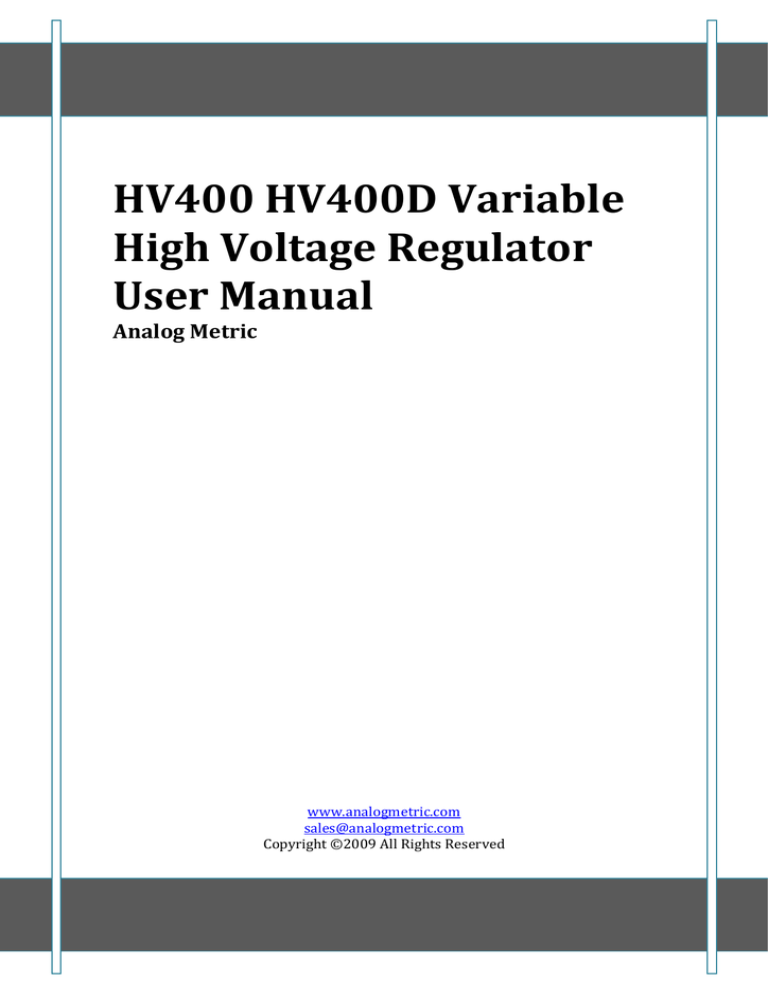
HV400 HV400D Variable
High Voltage Regulator
User Manual
Analog Metric
www.analogmetric.com
sales@analogmetric.com
Copyright ©2009 All Rights Reserved
[HV400 HV400D VARIABLE HIGH VOLTAGE REGULATOR
USER MANUAL] Analog Metric
FEATURES
1.
2.
3.
4.
5.
6.
7.
8.
9.
Output voltage range: 100-300V DC 100mA and 1.5-50V 5A
High voltage output voltage: Max. 300V DC 100mA for high voltage (HV) and 50V
5A for low voltage (LV)
Line regulation: < 0.06% and load regulation: <0.08%
Output voltages are adjusted by two resistor trimmers RV1 and RV2
Large reservoir capacitors for both HV and LV
Soft startup and reverse voltage protection.
Lowpass filter CRC or CLC with optional inductor 10H 150mA
Dedicated ground and power rails layout design
PCB dimension: 158mm x 98mm
www.analogmetric.com
Page 2
[HV400 HV400D VARIABLE HIGH VOLTAGE REGULATOR
USER MANUAL] Analog Metric
PRECAUTIONS
•
•
•
•
•
Do not use any body parts to touch the metal parts of the kit after power up or power
off, since the high voltage capacitors may not fully discharge. It may cause serious
electric shock.
Use a power transformer with fuse (1-3A) socket to limit the supply current in case of
short circuit or incorrect assembly.
Double check the assembled components with the schematics.
Do not attempt the measure the voltage by multimeter with hand after power up. The
probes of the multimeter should be mounted by some stands to the points of the
measurement before switching on the power supply.
Turn off the power supply if you observe any smokes or hear strange sound coming
out from the transformer or board. If there is short circuit, the transformer will be
getting very hot shortly.
PROCEDURES
1. Solder all the resistors and two blue resistor trimmers 500 and 5k Ohms (labeled with
501 and 502) according to the part list.
2. Solder two diodes D2 and D3, and 6V Zener diode. Notice the direction of the diodes
and Zener diode. There are white band marked in board corresponding to the bar of
the components. The Zener diode looks similar to the silicon diode (standard diode).
However, their operation direction of current flow is totally different.
3. Solder the power NPN transistor MJE5742, voltage regulators LM317/LM1805-ADJ
and LM1084-ADJ. Before soldering, they are mounted to the heat sinks by the
provided screws and silca insulator. Because their packages are identical, do not mix
up the NPN transistor with the regulators. It will cause irreversible damage to the
chips.
4. Solder the high voltage capacitors 100uF/450V and low voltage capacitors
10000uF/63V or 15000uF 63V. Notice to the polarity of the capacitors. There have
"+" screen silk marked in PCB corresponding to the positive terminals of the
capacitors.
5. Solder the remaining components.
6. Connect optional inductor 10H 100mA for further attenuation of the ripple voltage or
leave it unconnected.
7. For HV regulator, apply 100/200/220/240/260V AC (Maximum input voltage 260V
AC or 350V DC) to the connector (Blue).
For LV regulator, apply 8/12/15/18/24/27V AC to the connector (Blue).
www.analogmetric.com
Page 3
[HV400 HV400D VARIABLE HIGH VOLTAGE REGULATOR
USER MANUAL] Analog Metric
Notice: For LV regulator, the maximum input-output voltage difference regulator <
29V DC and minimum load current is 5mA (typical). For output current >3A, the
input-output voltage difference is recommended < 5V DC.
To increase the power efficiency of the regulator, the input-output voltage difference
should be minimized. Otherwise, the excess voltage will be dissipated as heat.
CONNECTION DIAGRAMS
Application example by connecting to T30 power transformer and 10H choke.
www.analogmetric.com
Page 4
[HV400 HV400D VARIABLE HIGH VOLTAGE REGULATOR
USER MANUAL] Analog Metric
Positive and negative high voltage supply by using two HV400 modules.
CHECKLIST
1. The direction of diodes and Zener diodes.
2. The polarity of the high voltage capacitors.
www.analogmetric.com
Page 5
[HV400 HV400D VARIABLE HIGH VOLTAGE REGULATOR
USER MANUAL] Analog Metric
TROUBLESHOOTING
The components marked by red circles are sensitive to damage and require checking with
the following steps:
1. Measure forward voltage of 6V Zener diode and diodes:
Zener diode D1 forward voltage
Diodes D2 and D3 forward voltage
2. Check the resistance of R1, R2, and R4:
www.analogmetric.com
Page 6
[HV400 HV400D VARIABLE HIGH VOLTAGE REGULATOR
USER MANUAL] Analog Metric
R2
R4
3. Check Vbe and Vbc of Q1 (NPN power transistor):
Vbe of Q1
Vbc of Q1
www.analogmetric.com
Page 7


